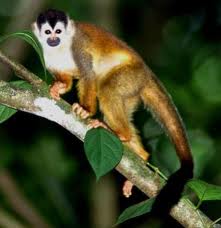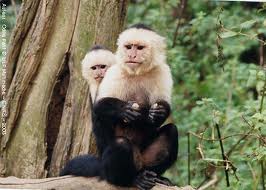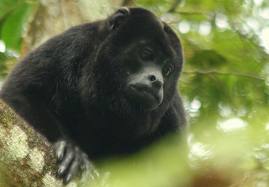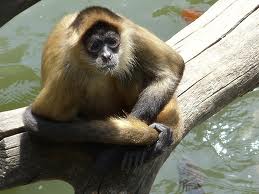-
Monkeys in Costa Rica
Costa Rica’s treasures include its lush forests and protected wildlife. Now incorporated with their eco-tourism, these animals can be viewed in their habitat courtesy of various national parks and biological reserves within the country. One of the animals that visitors can observe are the monkeys. Costa Rica is home to four species of monkeys namely the Central American Squirrel Monkey, White-Headed Capuchin, Mantled Howler and the Geoffroy’s Spider Monkey.
 Central American Squirrel Monkey
Central American Squirrel MonkeyDeclared as an endangered species, the Central American Squirrel Monkey is a small animal weighing only up to 2 kilos. It is mostly found in the Pacific Coast of Costa Rica as well as in the Corcovado Reserve and the Manuel Antonio National Park. Physically, the Central American Squirrel Monkey has a white and black mask resembling the tail of the squirrel, hence its name. Its back is orange as well as its hands and feet. These monkeys feed mostly on fruits and get their protein source from small insects like spiders, caterpillars and grasshoppers. The squirrel monkey is preyed by raptors, snakes and big cats in the jungle.
They often live in groups like most monkeys but stay mostly on trees. It is seldom to find these monkeys on the ground which makes the forests a big part of their survival. The Central American Squirrel Monkey is more active compared to other species specially on mornings and late afternoons.
Also called as “White-Faced Capuchin”, this species is named after the Capuchin monks due to the resemblance of its body coloring to the cowls worn by the friars. Right on the top of its crown to the rest of its body except the face, the white-headed capuchin is covered with black hair just like how a Capuchin monk looks. Medium-sized at 3.9 kilos, they are known for their intelligence in using tools to get food and rubbing plants into their fur for self-treatment. The White-Headed Capuchins are also trained as loyal companions for paraplegic people.
Some have light pink hair on their face with coiled tails. They can also live up to 54 years. Among other species, they are categorized as “least concern” and can be found in many national parks in Costa Rica like the Barra Honda and Juan Castro Blanco National Parks, Hitoy-Cerene Reserves and the Children’s Eternal Rainforest.
One of the largest monkeys weighing up to 9.8kilos, the Mantled Howler’s distinct features include its big size and the loud sound it creates. Its name came from the long hairs that blankets its whole body, a mantling fur coat and the howl it makes to signal other monkeys their respective locations. Only the male mantled holwers create the sound that is caused by an enlarged bone close to their vocal chords which in effect, amplifies their calls. Their howls can be heard as far as 1 kilometer away. The sound can be a little disconcerting when you first hear it, but it becomes a familiar and comforting sound once you get used to it. It’s nice to know they are near by when you hear them call.
Hair color range from black and brown and categorized as a “least concern” species. Leaves are the main source of their diet and spend most of their time sleeping or resting on branches of trees. Grouped to as much as 20, a large population of mantled howler monkeys can be found in La Selva Biological Station and Cabo Blanco Absolute Reserve.
Another endangered species of monkeys in Costa Rica, it called the “Black-Handed Spider Monkey” in reference to the black fur on its hands and arms in contrast to a lighter hair covering for the rest of its body. Geoffroy’s spider monkey is one of the largest species weighing up to 9kilos. The main distinction like other spider monkeys is the significant length of its arm in relation to its legs. Its arms are 25% longer than its legs while its tail is strong to carry its whole body weight. With these physical attributes, this monkey moves from one branch to another gracefully with its stretched limbs looking like a spider.
Its diet mostly consist of fruits especially ripe and fleshy ones. Some of them also eat young leaves. Natural predators are large felines like the puma as well as eagles and snakes.
Deforestration is the top threat of these monkeys as trees are their natural habitat and they rarely spend their days on the ground. Costa Rica, as the cradle of world eco-tourism, incorporates conservation and the protection of these species by setting up national parks and biological reserves as part of tourist attractions. Bringing tourists to observe these animals in their natural habitat builds awareness that will protect their existence.







